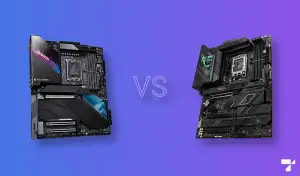825GB running on PCIe 4.0, NVMe M.2 at a blazing 8+ GB per second. At a glance, it seems that Sony did its proper homework to fully modernize the data storage capabilities of the PS5. It is, after all, one of the console’s biggest selling points as a next-generation product. But there is more to the PS5’s specs than just numbers and capacities. How it specifically works within the entire hardware’s custom system is also something very much worth analyzing.
What SSD Does the PS5 have?
The PS5 is compatible for use with a semi-custom NVMe M.2 SSD. It is a PCIe-based storage drive, the same type of thin, gum-shaped SSDs that we slot in motherboards for the last five years. Unlike SATA M.2 SSDs which have two pin splits on both sides of the connector and are still limited to SATA 6Gbps speeds (550 MB/s), NVMe SSDs can access the full PCIe (4.0) x4 data bandwidth of the M.2 slot they are connected to. This provides tremendous improvements to maximum read-write cycles, easily exceeding SATA-based connections several times over when the correct configuration is used.
PS5 SSD Specs
The default SSD included in a PS5 console has the following specifications:
| Storage Type | NVMe (PCIe 4.0, soldered) |
| NAND Type | TLC |
| Capacity | 825GB (667 GB effective) |
| Throughput | 5.5 GB/s (raw), 8-9 GB/s (typical) |
| Interface | 12-channel |
| Terabytes Written | 600 |
| Has DRAM cache? | Yes |
PS5 SSD Speed
Theoretically, with the use of a standard decompression unit, the PS5 can handle a throughput of 8 to 9 GB per second. As impressive as this sounds compared to the throughput of the original PS4 Pro HDDs (0.1 GB per second), this is fairly typical in terms of modern NVMe SSD speeds. For example, the Samsung 980 Pro, a similar PCIe 4.0 NVMe SSD that has a maximum sequential read speed of 7GB/s, provides near indistinguishable performance.
PS5 SSD Capacity
825GB seems pretty odd for a standard capacity value for an SSD, as most commercial drives are generally available 500GB, then 1TB, 2TB, and so on when offered above 250+ GB. This is because the specific capacity allows the best or maximum performance for its customized 12-channel interface. Also, accounting for various basic operational tasks and system files, the actual effective capacity (space dedicated for games) goes down to around 667GB.
PS5 SSD vs Xbox Series X SSD
While the PS5 SSD has an IO throughput of either 5.5GB/s (raw) or 9GB/s (compressed), the Xbox Series X SSD has a considerably lower spec of 2.4GB/s (raw) and 4.8GB/s (compressed). This makes the PS5 quite faster than the Xbox Series X, though the practical difference is usually only around eight to ten seconds in between. In most UI or OS-related functions, however, such as the initial boot-up, the Xbox Series X has the faster SSD.
PS5 Storage Expansion
Because the primary drive is directly soldered on the motherboard, the PS5 instead offers a storage expansion option in the form of another/extra M.2 slot. Much like inserting additional NVMe drives on laptops, this feature requires opening the console to gain access to the physical location of the slot on the motherboard. Take note that SATA M.2 SSDs (two-pin split M.2 drives) are not supported, and there are only specific NVMe drives that can be used for this option at the moment (refer to the list below).
How to Install an SSD in a PS5 Video Step by Step (With & Without Heatsink)
PS5 SSD Screw
PS5 SSD Screw Warning: PS5 SSD screws tend to strip easily! It is highly recommended that you use a needle nose plier when loosening or tightening the tiny SSD screw, and then just using the screwdriver when there is no more significant pressure put on the head indents. Remember, tighten just enough so there is enough resistance to the screw’s movement.
PS5 SSD Screw Replacement (and Spacer): If you did manage to strip the PS5 SSD screw, though, you can find appropriate replacements at online retail sites like Amazon.
PS5 SSD Compatibility List
This is a tentative list, as most of these drives are already available commercially at the time of this article’s writing. Expect more NVMe SSDs to be released (to be compatible) for the PS5 in the future.
| NVMe PCIe 4.0 SSD | Max Read/Write (MB/s)* | Capacities |
|---|---|---|
| Adata XPG GAMMIX S70 | 7400/6400 | 1TB, 2TB |
| Addlink A90 | 5000/4400 | 1TB, 2TB |
| Addlink A95 | 7400/7000 | 1TB, 2TB, 4TB |
| Corsair MP600 | 4950/4250 | 500GB, 1TB, 2TB |
| Corsair MP600 Pro LPX | 7100/5800 | 500GB, 1TB, 2TB, 4TB |
| Crucial P5 Plus | 6600/5000 | 500GB, 1TB, 2TB |
| Gigabyte Aorus | 5000/4000 | 500GB, 1TB, 2TB |
| Inland Performance Plus | 7000/6850 | 1TB, 2TB |
| Kingston Fury Renegade | 7300/7000 | 500GB, 1TB, 2TB, 4TB |
| Lexar NM800 | 7400/5800 | 500GB, 1TB |
| MSI Spatium M480 | 7000/6800 | 500GB, 1TB, 2TB |
| Mushkin Delta | 4975/3975 | 1TB, 2TB, 4TB |
| Mushkin Gamma | 7200/6900 | 1TB, 2TB, 4TB |
| Patriot Viper VP4300 | 7400/6800 | 1TB, 2TB |
| PNY XLR8 CS3140 | 7500/6850 | 1TB, 2TB, 4TB |
| Reletech P400 | 3500/2600 | 500GB, 1TB, 2TB |
| Sabrent Rocket 4 Plus | 7100/6600 | 1TB, 2TB, 4TB |
| Samsung 980 Pro | 7000/5000 | 250GB, 500GB, 1TB, 2TB |
| Seagate Firecuda 530 | 7300/7300 | 500GB, 1TB, 2TB, 4TB |
| Silicon Power US70 | 5000/4400 | 1TB, 2TB |
| Teamgroup CARDEA A440 | 7400/7000 | 1TB, 2TB, 4TB |
| WD Black SN850 | 7000/4100 | 500GB, 1TB, 2TB |
* – sequential read/write specs are for PC comparisons only
Final Thoughts
When the original PS4 was first launched (2013), computers have just begun to make SSDs more mainstream. As such, it was never the priority as the cost per byte was still way too high. Today, the PS5 leverages the leaps and bounds of the SSD industry to gain one of the most easily noticeable convenience factors of a modern PC: quick, sometimes near-negligible, loading times.
As for the question of whether 600 TBW is enough for the entirety of its lifespan, it should be more than adequate beyond its warranty of five years. After all, consoles tend to focus so much more on reading data, than writing them.



